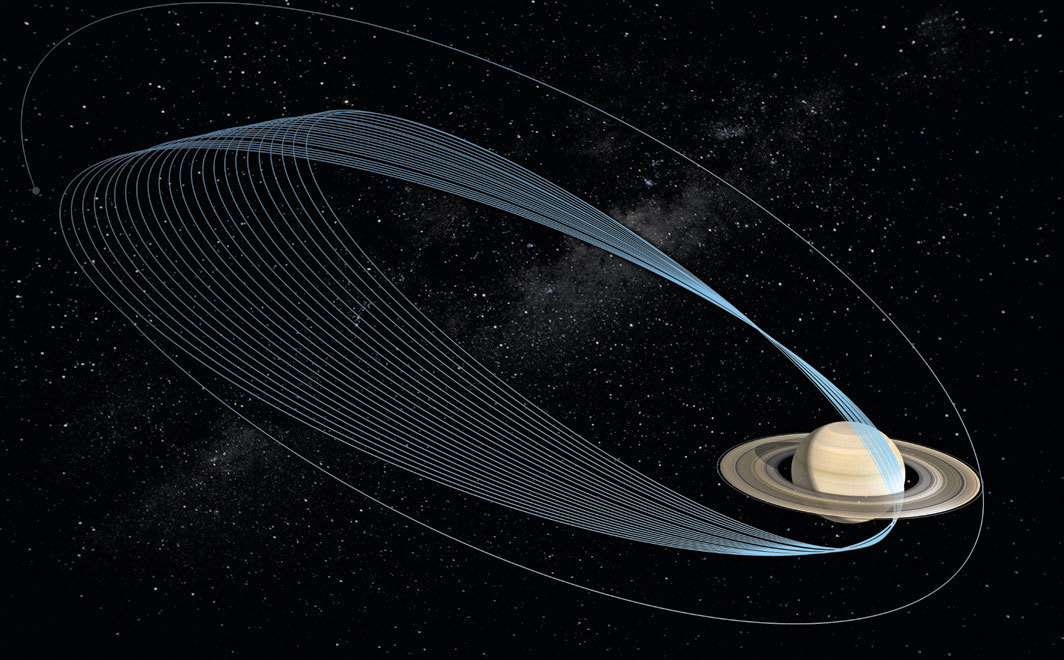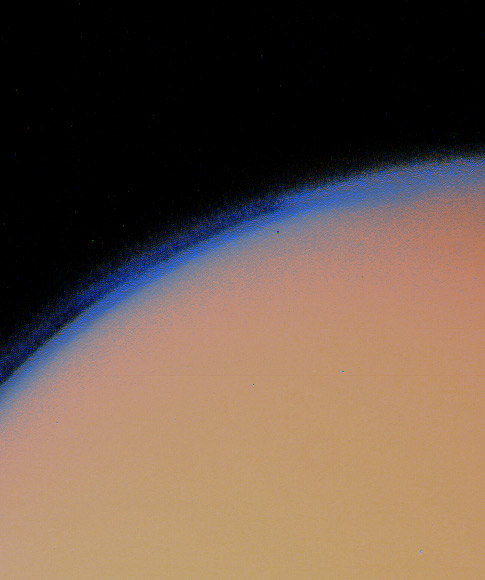Navigation

Key Points
◆ Cassini left Earth with less than one-thirtieth the propellant needed for all of the trajectory changes it would eventually make, but the navigation team used flybys of Saturn’s moon Titan to change trajectory.
◆ Like ancient seafarers, the Cassini navigation team used the stars to help navigate.
◆ Each of Cassini’s Saturn orbits lasted between a week and several months.
When Cassini’s journey ended in 2017, it had completed 294 orbits of Saturn and corrected its trajectory hundreds of times. Enormous planning went into every Cassini observation, but the element of the mission that made it possible to visit all the wonders of the Saturn system was navigation.
Cassini unraveled mysteries galore in the Saturn system by being where it was supposed to be, when it was supposed to be there. Yet Cassini arrived with but a fraction of the propellant needed to visit all the places on its itinerary. Instead of propellant, the navigation team used Saturn’s largest moon Titan to make the biggest changes to the spacecraft’s trajectory.
Titan Did the Heavy Lifting
Cassini’s combined orbits around Saturn look like a ball of yarn exploded without the threads breaking. The loops reach in all directions and are long in places but short in others. Though they appear disorderly, the sum of Cassini’s orbits represents a carefully choreographed, decade-long dance between Cassini and Titan.
“Titan is the engine of this tour,” said Duane Roth, chief of Cassini’s navigation team. After Cassini arrived at Saturn in 2004, Roth and his team of astrodynamicists at NASA's Jet Propulsion Laboratory used Titan to send the Cassini spacecraft swinging up, down and around the Saturn system.
Cassini’s total propellant at launch was enough to alter the spacecraft’s velocity by only about 5,400 miles per hour (2,400 meters per second), half of which was gone by the time the spacecraft reached Saturn. However, a single flyby of Titan at an altitude of 620 miles (about 1,000 kilometers), for example, gave Cassini a change in velocity of about 1,800 miles per hour (800 meters per second) — this is equivalent to one-third of Cassini’s total propellant at launch.
In spaceflight, change in velocity is called “delta-v.” The word “delta” refers to the Greek letter “D” and is used as a symbol in math and science formulas to mean “change,” and “v” refers to “velocity.” So “delta-v” or ∆v literally means “change of velocity.”
By mission’s end, Cassini achieved a delta-v of about 200,000 miles per hour (about 90,000 meters per second) from Titan flybys — roughly 37 times what it could ever have achieved by propellant alone. “What we carry in the spacecraft is a pittance compared to what we get from Titan,” Roth said.
When Cassini passed relatively close to Titan, the moon’s gravitational influence grabbed the spacecraft tightly and swung it around in a sharp turn. If Cassini performed a higher-altitude flyby, Titan’s grip was looser and the spacecraft’s trajectory was altered less. If Cassini passes by Titan’s southern hemisphere, the spacecraft’s path carried it “up” above Saturn’s ring plane (northward, relative to Saturn's equator), and if Cassini passed over Titan’s north, the spacecraft’s path bent southward, relative to the planet. In that way, Titan served as a pivot point for Cassini.
Generally, Cassini used propellant only to make small corrections that nudged it back toward its intended and ideal trajectory (called the “reference trajectory”) for the next Titan flyby. And each Titan flyby was designed to give Cassini the right direction and speed for its next Saturn orbit, lasting from a week to several months, during which it would observe particular moons or Saturn’s rings, for example. The encounters also lined up the spacecraft for its next Titan flyby.
“Every Titan flyby is a setup for the rest of the Titan flybys,” Roth said. If Cassini was off target in a flyby by half a mile (a kilometer), the spacecraft could burn a little propellant to correct the error. But if it missed by tens of miles, scientific observations might have to be rescheduled or even canceled. “It would take about six months to re-synchronize the trajectory with the science observations and would be like losing six months from the mission,” Roth said. Fortunately, that sort of replanning wasn't necessary since Cassini arrived at Saturn.
But, surprisingly, even though Titan played this essential role in Cassini's mission, no one knows where the moon is with absolute certainty.
Locating Titan, And Cassini
Prior to Cassini’s arrival, Titan was observed primarily from Earth and Earth orbit, where it appears as a tiny point of light. Voyagers 1 and 2 imaged Titan, but their observations were limited in time. The Voyager spacecraft raced through the Saturn system – they didn’t orbit Saturn.
“To complicate things, Titan has an atmosphere, so it looks like this fuzzy ball,” Roth said. “We missed our first flyby of Titan by a distance on the order of 20 kilometers [12 miles].” Since then, Cassini’s navigation team used each flyby to improve the accuracy of their knowledge of the moon’s orbit.

Perhaps more surprising, the exact position of Cassini itself was something of a permanent mystery. The navigation team estimated Cassini’s location by sending radio signals to the spacecraft from the powerful antennas of NASA's Deep Space Network. When Cassini received the signal more than an hour later, it immediately sent it back to Earth. Because the signal traveled at a fixed speed — the speed of light — the team was able to calculate Cassini’s distance by knowing precisely when the signal was sent from Earth and received from the spacecraft. And by measuring the shift in the frequency Cassini sent back (due to the Doppler effect), the navigation team calculated Cassini’s speed toward or away from Earth.
Like mariners of old, Cassini navigators also used the stars to understand their ship's position. The spacecraft’s cameras collected "optical navigation" images of Saturn's moons against a background of stars whose positions are well-known from astronomical measurements. But Cassini’s position was never nailed down with absolute certainty. “We can never know exactly where the spacecraft is,” Roth said. "But we've managed to do some amazing things flying the spacecraft with the knowledge we have.”
Among those amazing things was collaborating with ESA (the European Space Agency) to overcome a critical challenge early in the mission.
Science Through Teamwork
Having traveled together for seven years, the Cassini spacecraft and ESA’s Huygens probe parted ways not long after arriving at Saturn. As the first human-made probe to land on a moon in the outer solar system, Huygens was to parachute onto frigid Titan and send data to Cassini about the moon’s temperature, pressure and chemistry, and even photos from the surface.
But before Cassini-Huygens reached Saturn, ESA engineers determined that the Doppler shift of the probe’s data transmission was not properly accounted for in the design of the receiver system. Cassini was supposed to follow a path directly behind Huygens where the Doppler shift would be large. That meant Huygens would be sending its data at a frequency that its receiver aboard Cassini couldn’t translate.
Working together with their European colleagues, Cassini’s navigation team helped find a solution. “We changed the trajectory of Cassini so that its position was nearly perpendicular to the probe’s path,” Roth said. There the Doppler effect was minimal and the Huygens mission was able to proceed to great success.
“The European Space Agency noticed something wrong and they gave us time to fix it,” Roth said. “They deserve a lot of credit for identifying the problem in flight.”
Gravity Assists
From Cassini's launch through mission's end, “gravity assists” were essential for making the spacecraft go where the scientists wanted it to go.
Flybys
Flybys were a major element of Cassini's tour. The spacecraft's looping, elliptical path around Saturn was carefully designed to enable occasional visits to the many moons in the system. All flybys provided an opportunity to learn more about Saturn's icy satellites, and encounters with giant Titan were actually used to navigate the spacecraft, changing its orbit or setting up future flybys.





